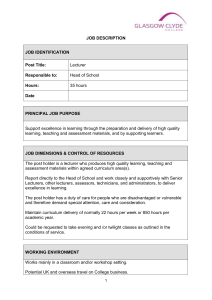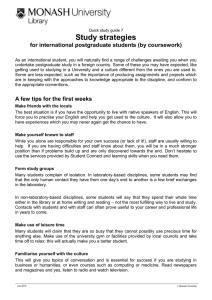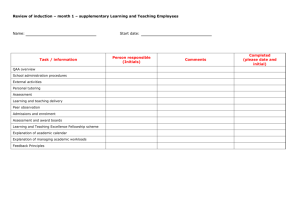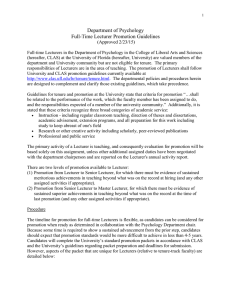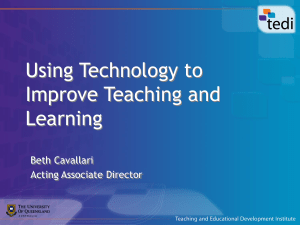DEVELOPING COMMUNICATION AND LECTURER’S CONTROL THROUGH LESSON STUDY
advertisement
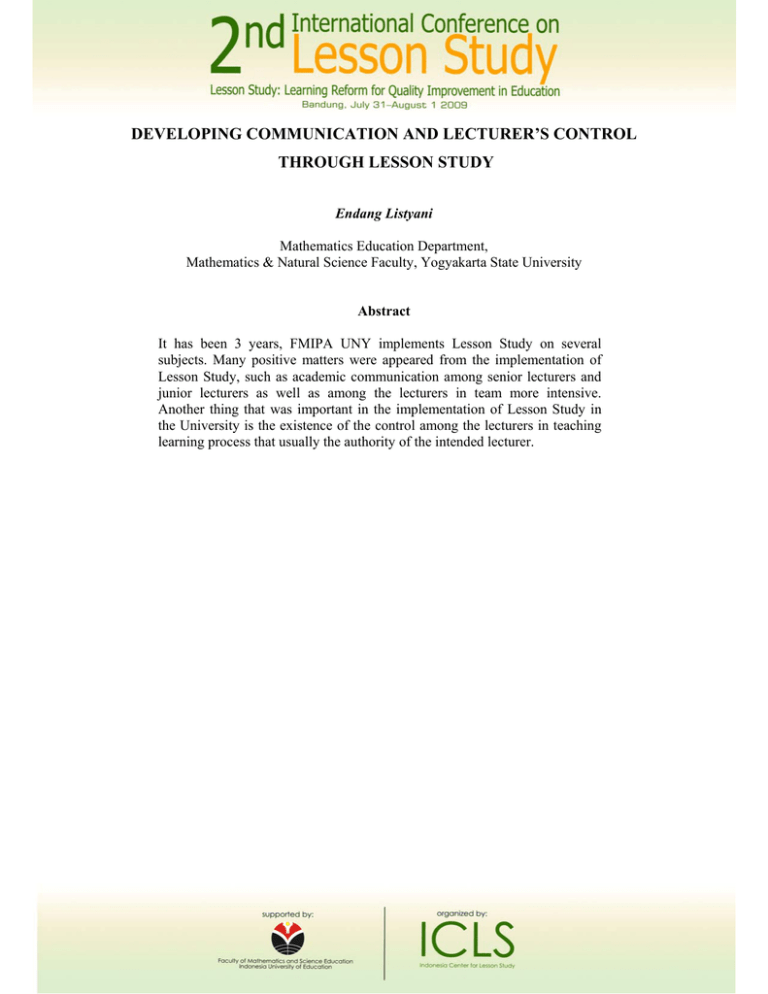
DEVELOPING COMMUNICATION AND LECTURER’S CONTROL THROUGH LESSON STUDY Endang Listyani Mathematics Education Department, Mathematics & Natural Science Faculty, Yogyakarta State University Abstract It has been 3 years, FMIPA UNY implements Lesson Study on several subjects. Many positive matters were appeared from the implementation of Lesson Study, such as academic communication among senior lecturers and junior lecturers as well as among the lecturers in team more intensive. Another thing that was important in the implementation of Lesson Study in the University is the existence of the control among the lecturers in teaching learning process that usually the authority of the intended lecturer. INTRODUCTION For the past three years, FMIPA UNY has implemented Lesson Study in 2 subjects in every semester and faculty. This implementation aims at improving the lesson quality and the academic situation in the faculty. A lesson is a way to manage the environment that gives colors to the optimum development and the growth of a learning program. Lecturers/ teachers, indeed, can learn about a lesson from their own experiences in teaching. Self evaluation to understand the success of his/her own lesson and many efforts done to solve the daily problems on the lesson are extremely important to improve the quality of a lesson. Yet, only learning from own lesson is not enough. If only the teachers/lectures are willing to learn from their colleagues experiences and able to accept criticisms or advices from them, it will be very possible for those lecturers to design and implement a lesson that truly guarantee the right of learning of every single student to learn optimally. The activity, in which the lecturers/teachers learn from a lesson, is known as ”Lesson Study”. Academic communication is built among the people who practice Lesson Study. It is undeniable that lecturers/teachers are able to give academic guidance directly to junior teachers/lecturers, yet, it is also possible for the junior lecturers/teachers to give input to their seniors (in a Lesson Study team). It is because the reflection section opens the opportunity for lecturers/teachers to accept critics and suggestions from other lecturers/teachers who become observers. At the same time, observers can give critics and suggestions that naturally will create the academicals atmosphere in the team. Generally speaking, a lecturer has a complete authority to manage a lesson. The plan and the implementation of the teaching learning process as well as the evaluation will be the lecturer’s individual complete responsibility. Yet, teachers are faced with different situation, in which they still get supervision from the head master/the school supervisor. Supervision is an activity, in which guidance and helps are given by supervisors to a teacher that aims at improving the quality of the work of the teacher in achieving the goal of the lesson. This kind of activity helps to control the work of the teacher so that they will be motivated to sustain and improve the quality of his/her lesson. The next question is, do lecturers need such supervision/control? Lesson Study builds the academic communication and control In Japan, teachers develop their ability of teaching through “Lesson Study” activity, a process where teachers are jointly plan, observe, analyze, and re-plan a lesson. According to Janzen (2005) “Lesson Study is an ongoing, collaborative, professional development process that was developed in Japan”. While Stigler and Hibert (in Sparks (1999)) state Lesson Study is a collaborative process in which a group of teachers identify an instructional problem, plan a lesson (which involves finding books and articles on the topic), teach the lesson (one member of the group teaches the lesson while the others observe), evaluate and revise the lesson, teach the revised lesson, again evaluate the lesson, and share the results with other teachers. In the same manner, Friedkin (2005) mention that Lesson Study is a process in which teachers jointly plan, observe, analyze, and refine actual classroom lessons called “ research lesson”, while the article cited in Northwest Regional Educational Laboratory (2004) mentions that Lesson Study is an ongoing professional practice in which teachers collaborate to plan, observe, and refine a lesson. Looking at those meanings, it can be concluded that Lesson Study is a collaborative activity, in which a group of teacher work collaboratively to: (1) plan the steps in a lesson, (2) one of the teachers teaches the plan while others observe the lesson, (3) evaluate the implementation of the lesson, (4) re-plan the lesson plan, (5) re-implement the revised plan, (6) re-evaluate the reimplementation of the lesson based on the revised plan, and (7) share the experience and findings from the evaluation result to other teachers. The pre-steps suggested to implement good Lesson Study activity are as follows • Lesson Study begins by forming a group or a team of Lesson Study. This team may consist of more than 2 lecturers/teachers of the same subject/group of subjects. It is suggested that the members of the team are chosen from various ages and teaching experiences background, so that a mutual learning process will be created for every member of the team. • After the team is established, it is important to hold a meeting to have the same perception of Lesson Study. The initiator of the team should be able to explain to the members of the team what Lesson Study really is. Then, every member is invited to give his/her opinion about Lesson Study. References about Lesson Study can be easily found in the internet. This discussion should come to the conclusion of Lesson Study, the objective of the implementation of Lesson Study, and the possible advantages of Lesson Study for every member of the team when joining Lesson Study. • The next step is to set up the focus of Lesson Study activity, especially the main material, method, and media that will be used in the lesson implemented in Lesson Study. In this step, the kind of main materials that should be the focus of the Lesson Study activity should be discussed and set up. The choosing of the main material or the main topic can be based on the experiences of the team members, i.e. the kinds of the main material that mostly failed by the students/ that create the learning problem for the students. Some questions, such as: ’what kind of method can be used to teach this topic?’, ’how was the result of the students’ learning in this topic?’, ’what basic competence should be mastered by the students in this topic?’, ’what learning experiences should have been learned by the students in this topic?’, ’what general problems are faced by the students?’, ’have the lesson effective for this topic through out this time?’, if it is effective, what is the best part of the effectiveness? and if is not, what are the main causes of the ineffectiveness? ’, etc, could be used as the opening session of the reflection until the main material, method, and media that will be used in Lesson Study are set up. • The intensive discussion to set up the focus of Lesson Study activity can also be started by listing the daily teaching learning problems faced by the members of the team. By doing so, every member of the team will be able to learn from the real problems. It is why, then, Lesson Study can be called as learning from the lesson. • After setting up the main material and method, the next step is preparing the lesson plan (RPP), LKS (students’ work sheets), media, and evaluation instrument, and the observation sheets, or, if it is necessary, the questionnaire for students could be added. The supporting devices needed for Lesson Study are microphone and video camera. Observation sheets contain the observations’ aspects. Documentation of the lesson becomes a very important part of the evaluation/reflection. • Besides the set of the learning equipments and the supporting devices listed above, the other important thing to be decided before the open lesson is the person who should be the model lecturer/teacher. At least once, every member of the team should be given a chance to be a model teacher. Besides the class setting, position or the space for the member of the team or other teachers to observe the class or the lesson, the “rules” between teacher and observer’s teachers should also be decided. Based on the jointly designed lesson plan/RPP, the model lecturer/teacher teaches in the front of the class and other members of the team observe the lesson. Since the objective of the planned and implemented lesson is to guarantee the right of the optimal learning of the students, it is suggested that the team members (observers) to focus on students’ learning, i.e. observing how the students or a group of students learn or learning from each other, how do they start and solve the problems given by the teacher, are there any students who do not involve in the learning process, are there any students who do not understand the concept discussed in the lesson. Besides observing the students’ learning activity, some matters such as the time prediction punctuality, the class management, and the fulfillment of the objectives of every step of the lesson can also be the target of the observers’ notes. After the making of the lesson plan (plan), the implementation of the lesson and observation (do), the next step is the reflection or the re-see (see) the implementation of the lesson. It is suggested to do the reflection after the implementation of the lesson by learning from the result of the observation of every observer and the video of the learning process. Reflection in the end of a lesson will be really useful for the improvement of the next lesson with the same students, or the lesson in the up coming year with different students. The data of the evaluation process can be filed through the observation sheets and the video of the lesson. Reflection starts with the reflection from the model lecturer/teacher. In this point, the model teacher/lecturer can give information about the condition of the students, some matters that s/he did that probably unsuitable with the RPP/lesson plan (if there is any) and the reasons, as well as what s/he felt and thought while the lesson was being implemented in the classroom. After the reflection from the model lecturer/teacher, the next step is the input or comments from the observer lecturer/teacher. The comments or suggestions should be based on the facts found during the lesson. After all comments and suggestions from the observers, the model lecturer/teacher, if it is necessary, can give his/her own comment or explanation. If a video player is available during the reflection, it will be better to show the video of the lesson. This video can be observed by the members of the reflection and can be used for the topic of the discussion. With the understanding of Lesson Study as the learning forum, in the efforts of improving the quality of a lesson so that lecturer/teacher could guarantee the right of every student to learn optimally, it is understandable that the spirit in every step of the reflection is to work together to find the solution of the problems occurred during the lesson, so that to make a better improvement and implementation of the next lesson. Besides other scientific forums that already become the places for the communication among lecturers/teachers, Lesson Study is, indeed, a place for the creation of the academic communication for lecturers/teachers. It is in this forum that the control system is also built for the lecturers in managing their lesson. The steps in Lesson Study, i.e. Plan-Do-See, allow every lecturer in the team to control or being controlled by other lecturers in implementing their lesson. CONCLUSION The discussion of the findings during the lesson, and the sharing of positive matters gained from Lesson Study, will be useful to improve the quality of the lesson of every member of the team. The reflection forum in Lesson Study could be a place for the senior teacher to guide their juniors, and at the same time, it is possible for the junior lecturers to have creative ideas that can be used by other lecturers, including the senior ones. This forum builds the academic communication system among lecturers; especially those who involve in Lesson Study team, besides other scientific forum such as seminars that long have been used as the scientific communication forum among lecturers. From the steps of Lesson Study, i.e. Plan-Do-See, a big opportunity is opened for the lecturers to have mutual control toward the lesson that used to be the main authority of the subject lecturer. REFERENCES Djamilah Bondan Widjajanti ( 2006). Sosialisasi Lesson Studi (Lesson Study Socialization). Yogyakarta, A Paper presented at PPM Friedkin, Shelley. 2005. What is Lesson Study?. http://www.lessonresearch.net/ . Glickman, Carl. D. 1981. Developmental Supervision: Alternative Practice for Helping Teacherss Improve Instruction. Alexandria: ASCD Janzen, Heidi. 2005. Using the Japanese Lesson Study in Mathematics. http://www. Glencoe.com/ Macomb Intermediate School District. 2005. Lesson Study. http://www.misd.net/lessonstudy/theme.htm. Northwest Regional Educational Laboratory. 2004. http://www.nwrel.org/msec/lessonstudy/overview.html. Overview Sparks, Dennis. 1999. Using Lesson Study to Improve Teaching. http://www.nsdc.org/library/publicatioms/results/res11-99spar.cfm. of Lesson Study.
